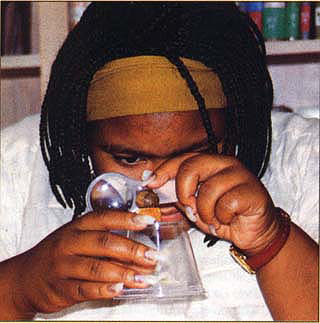All Issues
Sidebar: Students learn by doing in science program
Publication Information
California Agriculture 48(7):33-33.
Published December 01, 1994
PDF | Citation | Permissions
Full text
It began deceptively as a gentle roll but by the time it was over, just seconds later, the violent force of the motion had caused buildings to topple. “Uh oh, earthquake damage here,” cried one student, examining a corner of a hastily constructed high rise, where the paper clip had come loose from the plastic straw.
The students, tenth graders at Skyline High School in Oakland, were participating in SERIES, an informal teen-led science education program. Over two days, they practiced scientific thinking processes such as observation and inference by constructing high rises out of straws and paper clips, or Jell-O and marshmallows, to observe which structures held best in an earthquake and infer why. “The Jell-O foundation was just like the coastal area,” observed student Donna Cho.
The SERIES program has two aims — to teach science the fun way and prepare students to present the program to others, said SERIES Director Richard Ponzio.
“People say the best way to learn something is to teach it. I want them to learn by experience. That's how scientists build their own knowledge,” Ponzio said.
SERIES — the acronym for Science Experiences and Resources for Informal Educational Settings — began in 1987 as a joint project of the UC 4-H Youth Development Program, the Lawrence Hall of Science and UC Berkeley's Graduate School of Education. It has grown phenomenally since its California 4-H beginnings, and is now offered nationwide.
In fact, after seeing a SERIES workshop, the scientist Jane Goodall was so impressed with what teenagers can do that she wants to collaborate with SERIES to improve her international program for teens, Ponzio said. A team from the Jane Goodall Institute in Tanzania was expected to attend SERIES training workshops this fall.
The popularity has surprised Ponzio who said the original goal was simply to get students interested in science through a “hands-on approach.” That kind of teaching generally ends after kindergarten, he noted. “As you go up in grades, there's less and less of it and science becomes another reading lesson,” he said.
The curriculum is designed to start kids thinking about such issues as recycling and hazardous waste through units entitled “It Came from Planted Earth” and “Chemicals Are Us.” Teenagers not only learn about science; they then go out and teach the science to 9- to 12-year-olds, Ponzio said.
“We know that cross-age teaching is a very effective model. It's like teens coming in and saying, 'Hey, let's have fun with science,' ” he said.
Last year, the program expanded into public classrooms, training high school students enrolled in teaching magnet schools to lead elementary school students in the SERIES activities.
At Skyline High, for instance, SERIES participants were members of the Future Teacher's Academy. “I like kids and I like to teach,” said student Jean-Paul Holeman, who also goes by the name of “Snarled Rat” because of his green Mohawk haircut. “When they finally get it, I feel like I've accomplished something.”
Holeman was one of those attending the session on earthquakes, called “Beyond Duck, Cover and Hold.” In another session, this one involving chemistry, students dutifully followed directions, using salt and vinegar to wash residue off pennies. Then they discussed what worked best — a combination of salt and vinegar or one or the other alone. After the lesson, SERIES instructor Linda McFall pulled a surprise punch: what to do with the leftover waste from the experiment. “We've made a waste product and we need to figure out what to do with it,” she said. “Have we created hazardous waste?” she asked the class.
It is just this spirit of scientific inquiry the program hopes to encourage, said Ponzio and Richard Enfield, a 4-H Youth Development Advisor. “Science is an everyday occurrence,” said Enfield. “It's all around us but kids don't think of it like that.”
Teenagers who are part of SERIES also become valuable members of their communities. SERIES participants use their newly acquired scientific understanding and skills to build community gardens with seniors, make comparison beach cleanups, or organize community recycling projects, Enfield said.
Most important of all, they learn about science in a new and exciting way. “If they're inspired, who cares if they go into science?” Ponzio asked. “I just want them to know science is there for them.” —Editor





